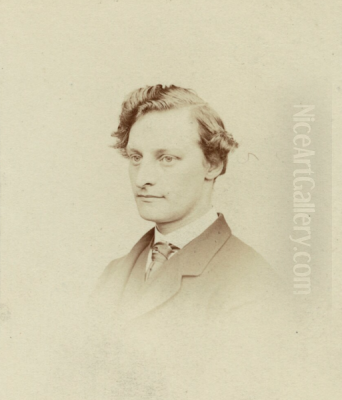
Edward Robert Hughes (1851-1914) stands as a significant, if sometimes overlooked, figure in the landscape of late Victorian and Edwardian art. A nephew of the esteemed Pre-Raphaelite painter Arthur Hughes, he carved his own niche, becoming particularly renowned for his exquisite and ethereal watercolours. His work, deeply imbued with the spirit of Aestheticism and Symbolism, transports viewers to realms of myth, legend, and poetic fantasy, rendered with a delicate touch and a masterful command of light and colour. Hughes was not merely a painter; he was a conjurer of dreams, a visual poet whose canvases shimmer with an otherworldly glow.
Early Life and Artistic Formation
Born in Clerkenwell, London, in 1851, Edward Robert Hughes, often known as "E.R. Hughes," was immersed in an artistic environment from a young age. His uncle, Arthur Hughes, was a prominent artist associated with the Pre-Raphaelite Brotherhood, and his influence on the young Edward was undoubtedly profound. This familial connection provided him with early exposure to the ideals of detailed observation, vibrant colour, and subjects drawn from literature and medieval romance that characterized the Pre-Raphaelite movement.
Seeking formal training, Hughes enrolled at the Royal Academy Schools in 1868. Here, he would have honed his technical skills in drawing and painting, absorbing the academic traditions while simultaneously being exposed to the evolving artistic currents of the time. The Royal Academy, while often seen as a bastion of traditionalism, was also a place where young artists could engage with diverse influences and begin to forge their individual paths. His time there laid a crucial foundation for his later, more distinctive style.
The Pre-Raphaelite Legacy and Aesthetic Ideals
While the original Pre-Raphaelite Brotherhood, founded in 1848 by William Holman Hunt, John Everett Millais, and Dante Gabriel Rossetti, had largely dissolved as a formal group by the time Hughes was establishing his career, its spirit lived on. Hughes is often considered a "second-generation" Pre-Raphaelite or, more accurately, an artist whose work evolved from Pre-Raphaelite principles into the burgeoning Aesthetic Movement and Symbolism.
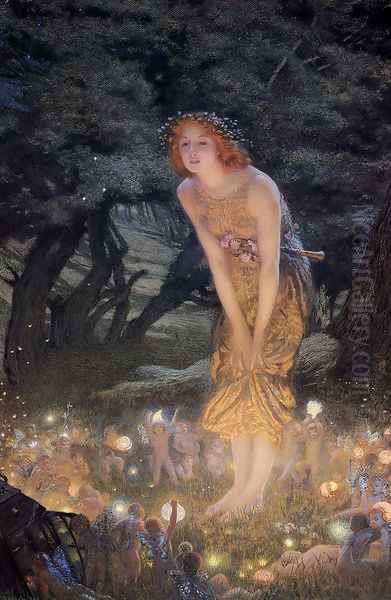
The early Pre-Raphaelites championed truth to nature, meticulous detail, and morally uplifting or romantic subjects. Artists like Ford Madox Brown, though never an official member, shared many of their aims. As the movement matured and new artists came to the fore, the emphasis shifted. Figures like Edward Burne-Jones, a close associate of Rossetti and William Morris, pushed Pre-Raphaelitism towards a more dreamlike, melancholic, and decorative style, heavily influenced by Italian Renaissance art and medieval legends. Hughes’s art aligns closely with this later phase, prioritizing beauty, mood, and symbolic resonance over strict naturalism or overt narrative. He shared with the Aesthetes the belief in "art for art's sake," where the primary aim of a work of art was to be beautiful and to evoke a sensory or emotional response, rather than to convey a didactic message.
A Vital Association: Assistant to William Holman Hunt
One of the most significant relationships in Hughes's professional life was his association with William Holman Hunt, one of the founding members of the Pre-Raphaelite Brotherhood. In Hunt's later years, his eyesight began to fail due to glaucoma, making it increasingly difficult for him to execute the highly detailed work for which he was famous. Hughes became his studio assistant, a role that required immense skill, sensitivity, and a deep understanding of Hunt's artistic vision.
This collaboration was particularly crucial for the completion of some of Hunt's most iconic later works. Hughes provided invaluable assistance on the large version of The Light of the World (c. 1900-1904), now housed in St Paul's Cathedral, a deeply symbolic painting that Hunt had first tackled decades earlier. He also helped Hunt with the later version of The Lady of Shalott (c. 1888-1905), a subject drawn from Tennyson's poem that resonated strongly with Pre-Raphaelite sensibilities. This period of working closely with such a revered figure undoubtedly enriched Hughes's own practice, offering him insights into technique and artistic perseverance. It also speaks volumes about Hughes's own technical prowess and his ability to adapt his hand to the meticulous demands of Hunt's style.
Artistic Style: Ethereal Beauty and Luminous Colour
Edward Robert Hughes is best known for his mastery of watercolour, often combined with gouache (an opaque watercolour) to achieve rich, jewel-like effects and luminous highlights. His style is characterized by its delicacy, intricate detail, and a distinctive, often mystical, use of colour, particularly blues, mauves, and golds, which lend his works a dreamlike, nocturnal quality.
His subjects were frequently drawn from literature – Shakespeare and Keats were particular favourites – as well as mythology, folklore, and purely imaginative themes. He had a penchant for depicting ethereal female figures, fairies, angels, and spirits, often set within enchanted landscapes or celestial realms. These figures are rarely robust or earthly; instead, they possess a fragile, otherworldly beauty, their forms often elongated and graceful, reminiscent of the figures in the works of Burne-Jones or even earlier Italian masters like Botticelli.
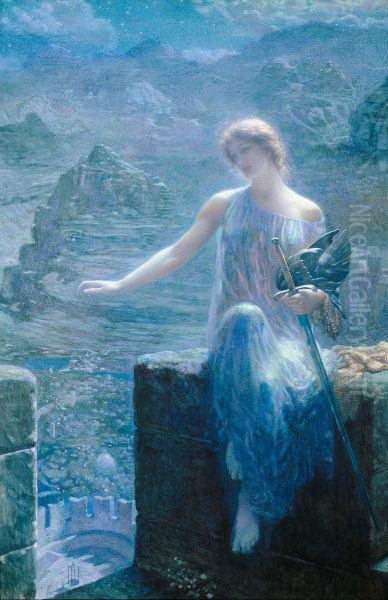
Hughes's handling of light is a defining feature of his art. He excelled at creating scenes bathed in moonlight, starlight, or a soft, diffused glow, which enhances the mystical and romantic atmosphere of his compositions. This careful manipulation of light and shadow, combined with his meticulous rendering of textures – shimmering fabrics, delicate wings, iridescent surfaces – contributes to the captivating, almost hypnotic quality of his paintings. While he also worked in oils, it is his watercolours that are most celebrated for their unique luminosity and poetic sensibility. His approach to fairy painting, for instance, moved beyond the often whimsical or grotesque depictions of earlier Victorian artists like Richard Dadd or John Anster Fitzgerald, imbuing his fairy folk with a more serene and spiritual grace.
Masterpieces in Focus: Visions of Myth and Dream
Several works stand out in Edward Robert Hughes's oeuvre, exemplifying his unique artistic vision.
_Midsummer Eve_ (c. 1908): This enchanting watercolour is perhaps one of his most famous works. Inspired by Shakespeare's A Midsummer Night's Dream, it depicts a young woman, possibly Hermia, asleep in a moonlit forest clearing, surrounded by a swirling host of ethereal fairies. The scene is bathed in a magical blue light, with tiny, luminous fairies dancing around the sleeping figure. Hughes masterfully captures the dreamlike atmosphere of the play, blending the natural world with the supernatural in a seamless and captivating vision. The delicate rendering of the fairies and the subtle play of light on the foliage showcase his exceptional skill in watercolour.
_Night with Her Train of Stars and Her Great Gift of Sleep_ (c. 1912): This painting is a quintessential example of Hughes's Symbolist tendencies. It personifies Night as a majestic, dark-robed figure, her cloak adorned with stars, gently leading a procession of smaller, sleeping figures or spirits. The work evokes a sense of peace, mystery, and the gentle embrace of slumber. The deep blues and violets, punctuated by the glittering gold of the stars, create a powerful and poetic image. It is a visual lullaby, a meditation on the restorative power of night and dreams. This work, with its allegorical depth, can be seen in dialogue with the Symbolist works of European artists like Gustave Moreau or Odilon Redon, though Hughes's interpretation remains distinctly his own.
_The Valkyrie's Vigil_ (1906): Drawing on Norse mythology, this powerful watercolour depicts a Valkyrie, one of Odin's warrior maidens, keeping watch. She is a figure of strength and solemn beauty, her gaze fixed on the horizon, perhaps awaiting the souls of fallen heroes. The dramatic lighting and the rich, sombre colours contribute to the epic and heroic mood of the piece. It demonstrates Hughes's ability to tackle more robust and dramatic themes, while still retaining his characteristic refinement and attention to detail.
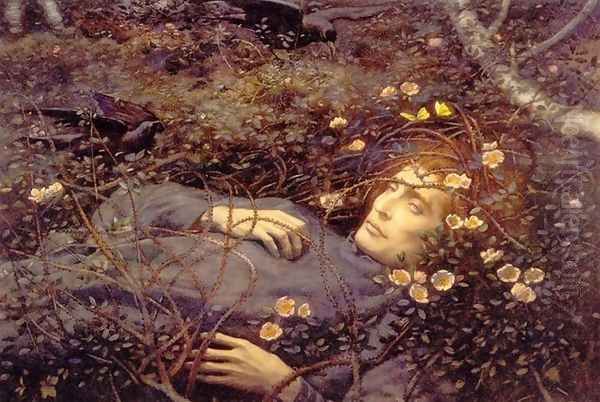
_Oh, What's That in the Hollow?_ (c. 1895): This intriguing title belongs to a work that captures the sense of wonder and slight trepidation associated with encountering the supernatural. Often depicting a figure peering into a mysterious, glowing hollow, it encapsulates the Victorian fascination with fairies and the hidden world. The use of light emanating from the unseen is a common motif in Hughes's work, adding to the sense of mystery and enchantment.
_Wings of the Morning_ (exhibited 1910): This title, likely inspired by Psalm 139 ("If I take the wings of the morning, and dwell in the uttermost parts of the sea..."), suggests an allegorical or spiritual theme. Hughes often explored such subjects, translating poetic or biblical phrases into luminous visual forms. His figures in such works often seem to be on a spiritual journey or in a state of divine contemplation.
_The Witch_ (exhibited 1902): This painting was chosen by the Royal Society of Painters in Water Colours (RWS) as their wedding gift to the future King George V and Queen Mary (then Duke and Duchess of Cornwall and York) for their coronation. This selection underscores the high regard in which Hughes was held by his peers and his ability to create works of significant appeal and artistic merit.
These works, among many others, reveal Hughes's consistent engagement with themes of beauty, mystery, and the unseen world. His art provided an escape from the increasingly industrialized and materialistic world of the late 19th and early 20th centuries, offering glimpses into realms of pure imagination.
The Aesthetic and Symbolist Dimensions
Hughes's art is deeply rooted in the Aesthetic Movement, which flourished in Britain in the later decades of the 19th century. Proponents of Aestheticism, such as James McNeill Whistler and Albert Moore, believed that art should exist for its own sake – for its beauty and its ability to create a pleasurable sensory experience – rather than for any moral, political, or narrative purpose. Hughes's emphasis on beautiful forms, harmonious colours, and evocative moods aligns perfectly with these ideals. His paintings are often less about telling a specific story and more about creating an atmosphere of enchantment and contemplation.

Furthermore, his work is rich in Symbolist qualities. Symbolism, an artistic and literary movement that originated in France, sought to express ideas and emotions through suggestive symbols and indirect allusions, rather than through direct representation. Hughes's personifications of Night, his depictions of angels and spirits, and his use of recurring motifs like stars and moonlight, all function symbolically, hinting at deeper meanings and inviting personal interpretation. His art shares a kinship with British Symbolist painters like Evelyn De Morgan, who also explored spiritual and mythological themes with a similar emphasis on decorative beauty and symbolic content.
Professional Life and Recognition
Edward Robert Hughes was an active and respected member of the London art world. He exhibited regularly at prestigious venues, including the Royal Academy, the Grosvenor Gallery (a key venue for Aesthetic and Pre-Raphaelite-influenced art), the New Gallery, and, most significantly, the Royal Society of Painters in Water Colours (RWS).
His association with the RWS was particularly important. He was elected an Associate of the RWS (ARWS) in 1891 and became a full member (RWS) in 1895. His dedication and skill were further recognized when he served as Vice-President of the RWS from 1901 to 1903. This institution was central to the promotion and appreciation of watercolour painting in Britain, and Hughes's prominent role within it highlights his status as a leading practitioner of the medium. He was also a member of the Art Workers' Guild, an organization founded in 1884 by architects and designers associated with the Arts and Crafts movement, which aimed to break down the barriers between fine art and applied arts and to promote high standards of craftsmanship. This affiliation suggests Hughes's broader interest in the principles of good design and skilled execution across various artistic disciplines.
Other artists of the period who shared similar thematic concerns or stylistic leanings, and with whom Hughes's work can be compared, include John William Waterhouse, known for his romantic depictions of mythological and Arthurian women, and Sidney Harold Meteyard, another artist associated with the later Birmingham School who produced richly coloured, decorative works. Even the earlier, more academic classicism of Frederic Leighton sometimes touched upon similar mythological subjects, though with a different stylistic approach.
Later Years and Enduring Legacy
Edward Robert Hughes continued to paint and exhibit throughout his life. He moved to St Albans, Hertfordshire, in his later years, seeking a quieter environment away from the bustle of London, though he remained connected to the art world. He passed away in St Albans on April 23, 1914, at the age of 62, leaving behind a significant body of work that continues to enchant and inspire.
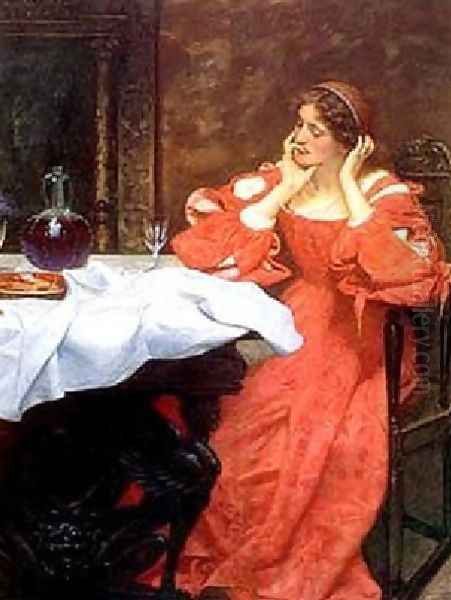
While perhaps not as widely known today as some of the founding Pre-Raphaelites or more flamboyant figures of the Aesthetic Movement, Hughes's contribution to British art is undeniable. He was a consummate craftsman, particularly in the demanding medium of watercolour, and a visionary artist who created a unique world of poetic fantasy. His paintings offer a portal to an ethereal realm, characterized by delicate beauty, luminous colour, and a profound sense of mystery.
His legacy lies in his ability to sustain and reinterpret the romantic and imaginative traditions of Pre-Raphaelitism, infusing them with the sensibilities of Aestheticism and Symbolism. In an era of rapid social and technological change, Hughes's art provided a space for contemplation and wonder, celebrating the power of dreams, myths, and the enduring allure of beauty. His works are held in numerous public collections, including the Birmingham Museum and Art Gallery, the Ashmolean Museum in Oxford, and the Victoria and Albert Museum in London, ensuring that his luminous visions continue to be appreciated by new generations. He remains a testament to the enduring power of art to transport us beyond the everyday, into realms of magic and poetic truth.